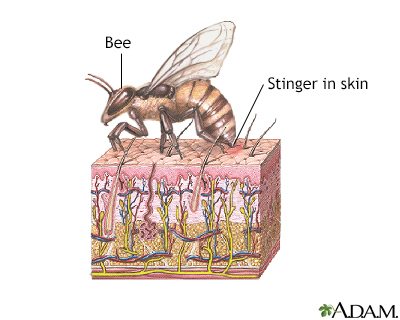Bug repellent safety
Definition
A bug repellent is a substance that is applied to the skin or clothing to protect you against biting insects.
Alternative Names
Insect repellent safety
Information
The safest bug repellent is to wear proper clothing.
- Wear a full-brimmed hat to protect your head and the back of your neck.
- Make sure your ankles and wrists are covered. Tuck pant cuffs into socks.
- Wear light-colored clothing. Light colors are less attractive than dark colors to biting insects. It also makes it easier to spot ticks or insects that have landed.
- Wear gloves, particularly while gardening.
- Check clothes regularly for bugs.
- Use protective netting around sleeping and eating areas to keep bugs at bay.
Even with proper clothing, when visiting an area with many insects, bug repellents such as those containing DEET or picaridin should be used.
- To avoid skin irritation, apply insect repellent to clothing. Test the repellent on a small, hidden area of clothing first to see if it will bleach or discolor the fabric.
- If areas of your skin are exposed, apply repellent there as well.
- Avoid using directly on sunburned skin.
- If using both sunscreen and repellent, apply sunscreen first and wait 30 minutes before applying repellent.
To avoid toxicity from insect repellents:
- Follow label instructions on how to use the repellent.
- Do not use in infants under 2 months of age.
- Apply repellent sparingly and only to exposed skin or clothing. Keep out of eyes.
- Avoid using high-concentration products on the skin, unless there is a high risk of disease.
- Use a lower concentration of DEET (under 30%) on pregnant women and small children.
- Do not breathe in or swallow repellents.
- Do not apply repellent to children's hands because they are likely to rub their eyes or put their hands in their mouth.
- Children age 2 months to 2 years old should not have insect repellent applied to their skin more than once in 24 hours.
- Wash repellent off the skin after the risk of being bitten by an insect is gone.
Gallery

References
Fradin MS. Insect protection. In: Keystone JS, Kozarsky PE, Connor BA, Nothdurft HD, Mendelson M, Leder K, eds. Travel Medicine. 4th ed. Philadelphia, PA: Elsevier; 2019:chap 6.
United States Environmental Protection Agency website. Repellents: protection against mosquitoes, ticks and other arthropods. www.epa.gov/insect-repellents. Updated June 16, 2021. Accessed August 13, 2021.